Recipe #4: Puha, refreshing tamarind drink
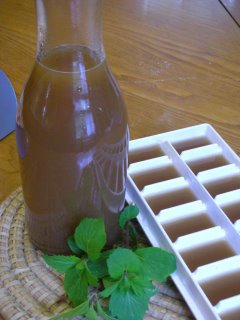 Did you know that the name of the capital of Senegal, "Dakar," comes from the Wolof word for "tamarind"? Also, that tamarind originated, not in India, but in Africa [even though its common English name comes from the Arabic tamar-u'l-Hind, meaning "the date of India"?] Or that tamarind is the "secret" ingredient in many barbeque sauces as well as Worcestershire sauce? Tamarind has a wonderful sweet-tart flavor that makes it a favorite for drinks throughout Africa. For more fascinating detailed information about it and its varied uses on the continent, check out Vol III of the Lost Crops of Africa.
Did you know that the name of the capital of Senegal, "Dakar," comes from the Wolof word for "tamarind"? Also, that tamarind originated, not in India, but in Africa [even though its common English name comes from the Arabic tamar-u'l-Hind, meaning "the date of India"?] Or that tamarind is the "secret" ingredient in many barbeque sauces as well as Worcestershire sauce? Tamarind has a wonderful sweet-tart flavor that makes it a favorite for drinks throughout Africa. For more fascinating detailed information about it and its varied uses on the continent, check out Vol III of the Lost Crops of Africa.I once spent a pleasant afternoon in Tamale, northern Ghana, with the industrious Mrs. Comfort Awu Akor and her daughter Amadu George Shetu learning to make a popular tamarind drink known by the Hausa word "Puha." Comfort made it in commercial quantities (over 13 gallons) to sell from her home in little plastic bags chilled or frozen in her refrigerator and/or freezer, but I have modified the recipe. Also, she used "2 bags of masoro." Masoro is the Hausa name for a kind of spice also known as " Ashanti pepper" or "false cubeb pepper" in English, or "soro wisa" in Twi. It's unavailable to me where I live in State College, Pennsylvania.
While in Ghana the tamarind is processed into balls and sold in the outdoor markets, in the U.S. it is possible to get imported plastic packages of "soft" or "wet" tamarind from places like Thailand and India. The one I have right now from Thailand has salt added to it, so I'm using the Indian package (about 8 ounces), even though I've read that the Thai tamarind tends to be sweeter and the Indian more sour.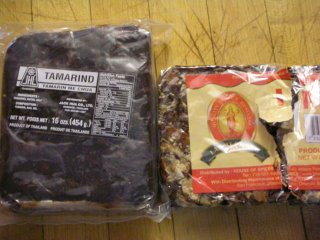 (BTW, I cut the Indian package before I remembered to take a picture). The Indian tamarind was from our local Wegman's. It's also possible to buy tamarind concentrate, which would probably make this process faster and easier, but I'm sticking today with a more traditional approach. This recipe makes about 1/2 gallon. I'll include photos I took as I worked. They're not fancy, but if you want to see how the process goes, they should do the trick.
(BTW, I cut the Indian package before I remembered to take a picture). The Indian tamarind was from our local Wegman's. It's also possible to buy tamarind concentrate, which would probably make this process faster and easier, but I'm sticking today with a more traditional approach. This recipe makes about 1/2 gallon. I'll include photos I took as I worked. They're not fancy, but if you want to see how the process goes, they should do the trick.
 (BTW, I cut the Indian package before I remembered to take a picture). The Indian tamarind was from our local Wegman's. It's also possible to buy tamarind concentrate, which would probably make this process faster and easier, but I'm sticking today with a more traditional approach. This recipe makes about 1/2 gallon. I'll include photos I took as I worked. They're not fancy, but if you want to see how the process goes, they should do the trick.
(BTW, I cut the Indian package before I remembered to take a picture). The Indian tamarind was from our local Wegman's. It's also possible to buy tamarind concentrate, which would probably make this process faster and easier, but I'm sticking today with a more traditional approach. This recipe makes about 1/2 gallon. I'll include photos I took as I worked. They're not fancy, but if you want to see how the process goes, they should do the trick.Boil 3 cups of water and add about 4 oz (or 125 grams) of packaged tamarind (without salt). Stir it to break it up and let it steep for an hour or two.
While it is steeping, gather the other ingredients:

1 teaspoon whole cloves
1/2 teaspoon whole peppercorns (I'm substituting black peppercorns for the masoro, reducing the quantity, and hoping they won't be too strong)
about 3 tablespoons of peeled, ground or grated ginger
2 cups of sugar
1/2 teaspoon whole peppercorns (I'm substituting black peppercorns for the masoro, reducing the quantity, and hoping they won't be too strong)
about 3 tablespoons of peeled, ground or grated ginger
2 cups of sugar
As far as special equipment goes, besides the pan for boiling the water you could use a small mortar and pestle for breaking up the cloves and peppercorns, a frying pan for lightly toasting the pepper, a large strainer, a smaller tea strainer, several (stainless steel) bowls, measuring spoons, a vegetable peeler for peeling the ginger, a grater for grating it, a container for storing the puha (and an ice cube tray if you decide to freeze a little of the puha as I explain below).
After the water with the tamarind has cooled, I use my (clean!) hands to squeeze it thoroughly to remove the pulp from the seeds before I move on to the next step. (This is similar to how one squeezes palm nuts to remove the pulp from the seeds when making palmnut soup from the actual palm nuts.)
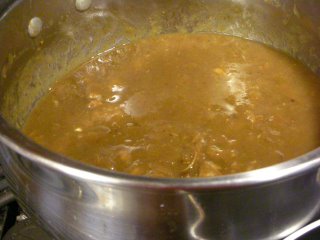
Peel and grate the ginger, lightly toast the peppercorns for a minute or so, then crush the cloves and peppercorns in the mortar and pestle.
Put about 3 cups of cold water in a clean bowl, set the large strainer over a different bowl, and pour the tamarind/water mixture into the empty bowl, shaking it and using your hand to squeeze as much liquid as possible out of the mixture. In several batches, pour some of the 3 cups of clear water in the other bowl through the strainer, continuing to strain as much of the water/pulp mixture into the bowl you first strained into. When you have finished with the 3 cups of clear water and have as much tamarind liquid in the bowl as possible, discard the seeds, and other pieces of tamarind in the strainer, and rinse it clean. Put about 3 more cups of water into the empty bowl, and add the ginger, pepper and
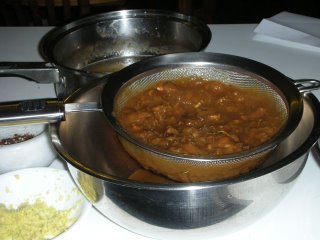 cloves in the bowl. Stir them and let them sit in the water for several minutes. Then, using the tea strainer, strain the water with the ginger and spices into the tamarind mixture. Discard the ginger/spice mixture. For the final step, I usually strain the mixture one last time, then put a few cups of the tamarind mix into a bowl and add about 1 3/4 cups of sugar (in Ghana they likely use more sugar to make a sweeter drink than I prefer), or to your taste. Mix it until the sugar dissolves, then add it back into the bowl with the other tamarind mixture.
cloves in the bowl. Stir them and let them sit in the water for several minutes. Then, using the tea strainer, strain the water with the ginger and spices into the tamarind mixture. Discard the ginger/spice mixture. For the final step, I usually strain the mixture one last time, then put a few cups of the tamarind mix into a bowl and add about 1 3/4 cups of sugar (in Ghana they likely use more sugar to make a sweeter drink than I prefer), or to your taste. Mix it until the sugar dissolves, then add it back into the bowl with the other tamarind mixture.Voila! Puha. My favorite way to serve puha is to freeze it into small cubes and use it as a palate cleanser between dinner courses, but it is also a refreshing cold drink, which people claim has various health benefits. Incidentally, tamarind drink is also popular in Mexico and Asia. Goya and other companies sell it in cans, as shown below. However, the can below contains only water, tamarind pulp, sugar, and high fructose corn syrup. I prefer freshly made, slightly spicy West African puha. And for those who are concerned about sugar intake, it should be a simple matter to substitute something like Splenda for the sugar.
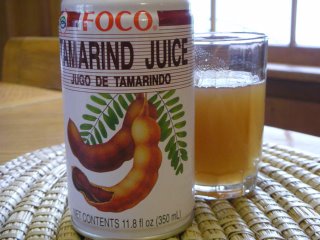
Labels: african beverage, masoro, puha, soro wisa, tamarind
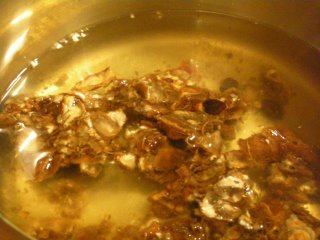


0 Comments:
Post a Comment
<< Home